NCC 2022 Volume One - Building Code of Australia Class 2 to 9 buildings
Search the National Construction Code editions
C4
Part C4 Protection of openingsThis Part contains Deemed-to-Satisfy Provisions for Part C1. It covers the protection of openings such as windows, doors, services and construction joints to reduce the risk of fire spread within or between buildings.
To clarify that the requirements of C1P1 to C1P9 will be satisfied if the building complies with Parts C2, C3 and C4, and Parts G3, I1 and I3, if applicable
See Deemed-to-Satisfy Provisions for Part C2. The same applies here.
To clarify which openings must comply with the Deemed-to-Satisfy Provisions of Part C4.
Openings listed in C4D2(1) need not comply with the Deemed-to-Satisfy Provisions of Part C4.
However, for the purposes of C4D2(1)(d) and (e) multiple storeys within a carpark connected by openings formed by a vehicle ramp are considered to be within the same fire compartment and therefore sprinkler protection may be required under E1D9.
Openings listed in C4D2(2) and (3) must comply with the relevant Part C4 Deemed-to-Satisfy Provisions.
To require any opening in external walls to be protected, only where the wall is required to have an FRL, to prevent the spread of fire from the boundary of an adjoining allotment, or one building to another building on the same allotment.
C4D3 applies to all Class 2–9 buildings, even those protected by a sprinkler system. The provisions only apply to openings which are exposed to a fire source feature (i.e. an allotment boundary or another building on the same allotment) and which are located in an external wall required to have an FRL (see Figure C4D3).
Any openings in the external walls of buildings separated by fire walls must comply with C4D3 In this case, each building is a fire-source feature to the other building (see Figure C4D3).
Protection of openings
Openings in an external wall must be protected if within 3 metres of a side or rear boundary (see C4D3(2)(a)). Or, under C4D3(2)(b), if they are within 6 metres of the far boundary of an adjoining road, etc, if the opening is located in a storey above, or a reasonable distance from ground level. Openings must also be protected if they are within 6 metres of another non-Class 10 building on the allotment (see C4D3(2)(c)).
In regards to the protection of openings under C4D3(2)(b), an assessment is required to determine a “reasonable” distance from ground level, on a case by case basis. Discussions with the appropriate authority may be required in this regard.
Under C4D3(3), openings in an external wall must be limited to the size specified if the openings are required to be protected under C4D3(1). This is unless the openings are in a Class 9b open spectator stand.
Figure C4D3: Plan showing when C4D3 requires protection of openings in an external wall required to have an FRL
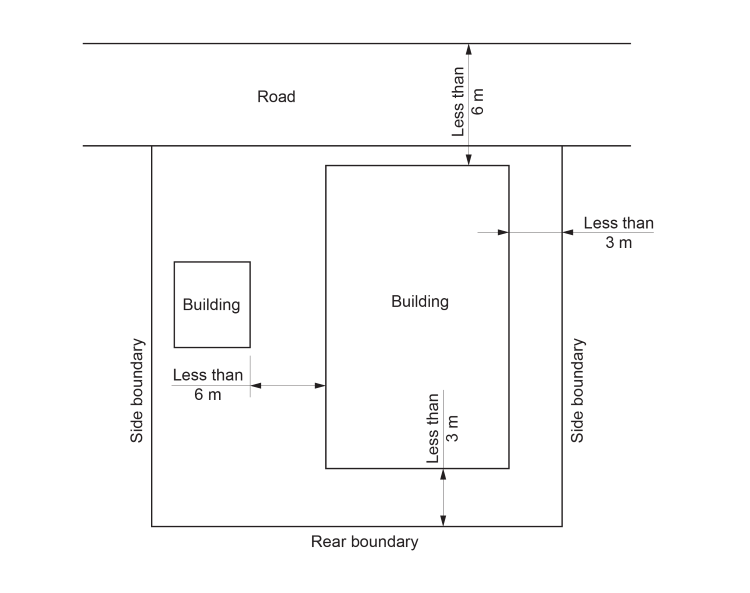
The distance between parts of external walls and any openings within them in different fire compartments separated by a fire wall must not be less than that set out in Table C4D4, unless—
| Angle between walls | Minimum distance (m) |
|---|---|
| 0° (walls opposite) | 6 |
| more than 0° to 45° | 5 |
| more than 45° to 90° | 4 |
| more than 90° to 135° | 3 |
| more than 135° to less than 180° | 2 |
| 180° or more | Nil |
To limit the spread of fire between fire compartments through external walls and the openings in them.
Figure C4D4 illustrates the use of Table C4D4.
When the walls are at an angle of 180º or greater, the distance betweenthem may be zero because the effects of radiant heat between the walls is negligible. In practice, the distance between such walls is likely to equal the width of the fire wall.
Sole-occupancy units in Class 2 and Class 3 buildings are not fire compartments to which C4D4 applies.
C4D4 applies to both external walls. It does not apply to fire walls separating fire compartments. (A fire wall is not always an internal wall. See Figure C3D8c of this Guide).
Figure C4D4: Plan showing illustration of Table C4D4
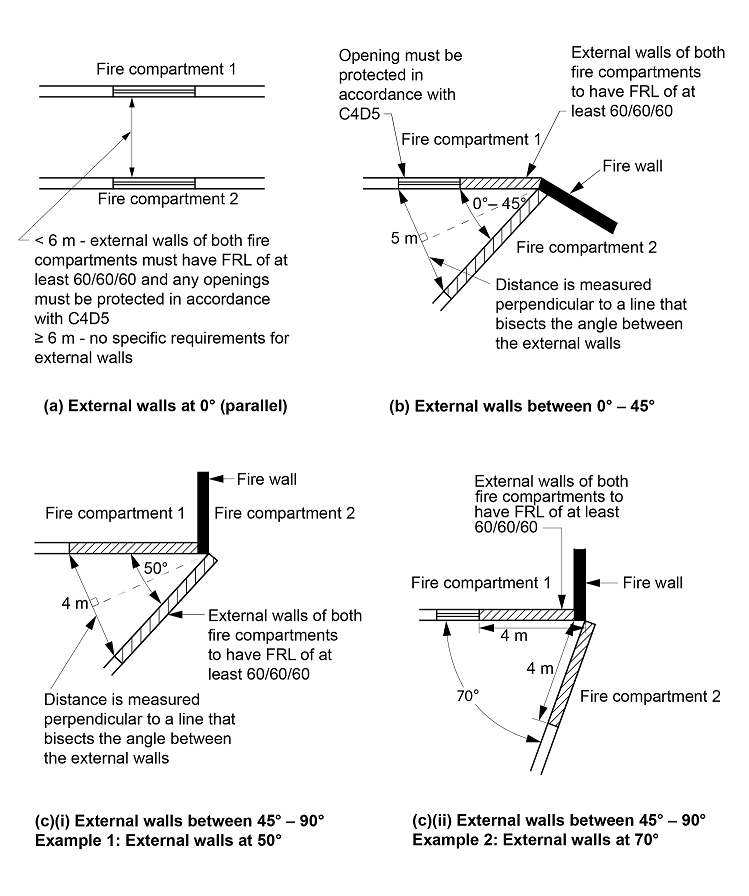
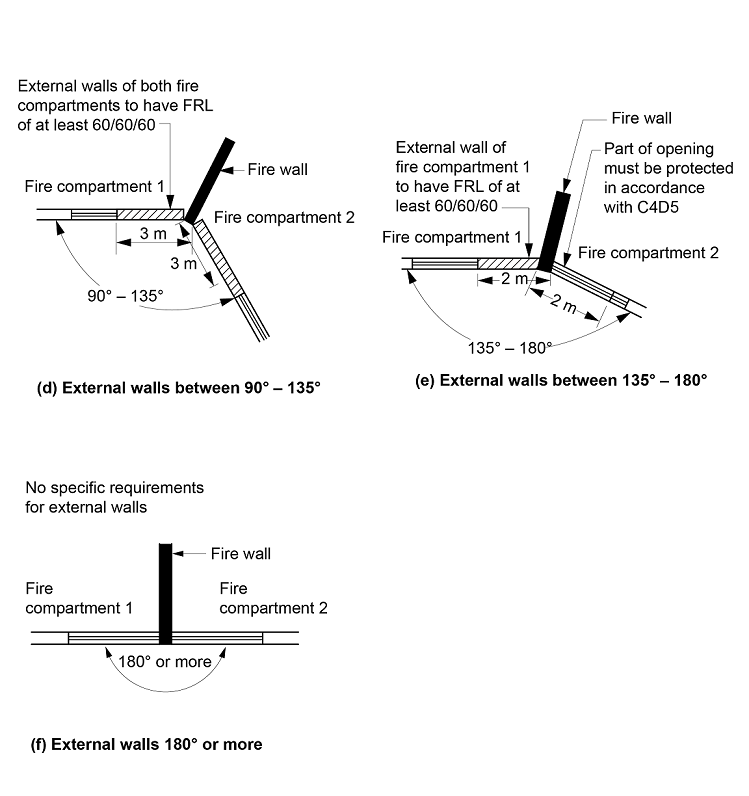
To set out acceptable methods of protection required for different types of openings in a building.
C4D5(1) applies where protection is required to doorways, windows and other openings. C4D5(2) requires fire doors, fire windows and fire shutters to comply with Specification 12.
C4D5 is referred to by a number of the BCA’s Deemed-to-Satisfy Provisions. Some of these provisions will specify whether or not a required sprinkler system must be internal or external. Where external wall wetting sprinklers are proposed, it may be designed using AS 2118.2, even though that Australian Standard is not referenced in the BCA. Please note that there are certain limitations that apply to AS 2118.2, such as the types of glazing applicable and location of sprinkler heads.
Examples
Examples of the references to C4D5 in the other Deemed-to-Satisfy Provisions include the following:
C4D5(1)(a) clarifies that wall-wetting sprinklers are only to be used with doors that are self-closing or automatic closing.
C4D5(1)(b) clarifies that wall-wetting sprinklers are only to be used with automatic closing windows or permanently closed windows.
For openings other than doorways or windows, C4D5(1)(c)(i) clarifies that internal or external wall-wetting sprinklers are not recognised as an acceptable method of protection for voids under the Deemed-to-Satisfy Provisions. Conventional wall-wetting sprinklers need a medium or surface to act on. An opening consisting of a void does not provide such a medium or surface.
To maintain the integrity of fire walls by limiting the spread of fire through doorways.
If the opening in the fire wall is for a horizontal exit, refer to C4D8.
When a doorwayis installed in a fire wall, to achieve the same fire separation as the wall, C4D6(1) allows the use of:
(See C4D6(1)(a), C4D6(1)(b)and C4D6(1)(c))
In each option, the single fire door or shutter, or any of the combinations of the two, must have the same fire-resistance level (FRL) as the fire wall. (This is except for the insulation criterion, which must be at least 30 minutes)
When determining the required FRL of the fire door or shutter, Clause S1C6 of Specification 1 states that non-loadbearing elements need not comply with the structural adequacy criterion. A fire door or shutter is normally regarded as a non- loadbearing element.
Examples
Consider the case of a fire wall required to have an FRL of 240/240/240. After taking into account the concession allowed by S1C6, C4D6 allows any doorway in that wall to be protected by:
Closure of fire doors and shutters
C4D6(2) states that any fire door or shutter required under C4D6(1) must be either self-closing or automatic-closing. If automatic closing, it must be initiated by smoke detectors, or (in specified circumstances) any other detector deemed suitable in accordance with AS 1670.1(see C4D6(3)). It is important that the detector used is suitable for the location and type of fire likely to occur. The suitability of detectors can be determined by reference to AS 1670.1. These detectors must also be in accord with the relevant provisions of AS 1670.1, and located as specified in C4D6(3).
Under C4D6(4), the activation of any other required suitable fire alarm system (including a complying sprinkler system), in either of the fire compartments separated by the fire wall, must operate the automatic closing of the fire door or shutter.
Asmoke detector can give false alarms if the atmosphere contains particles such as steam or other vapours that obscure vision (e.g. kitchens, carparks, etc). If a smoke detector is likely to give a false alarm due to the atmospheric conditions, then a heat detector should be used to comply with C4D6(3).
Figure C4D6 illustrates the requirements of C4D6.
Figure C4D6: Plan illustrating automatic fire doors or automatic fire shutters installed in an opening in a fire wall in accordance with C4D6
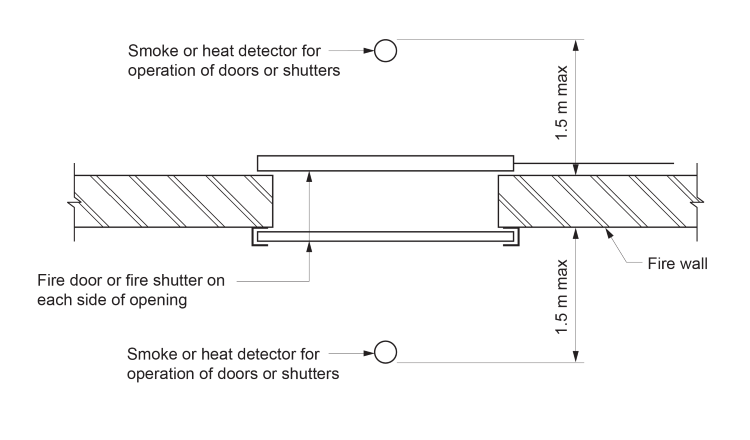
To avoid danger to occupants caused by the automatic closing of a sliding fire door.
It is an acceptable and frequently used option to protect an opening in a fire wall by a sliding fire door held open by an electromagnetic device. However, sliding fire doors tend to be quite large and heavy, presenting a potential danger to occupants passing through while it is closing. To reduce the danger to building occupants the rate of the door’s closing is limited and must be by the deactivation of an electromagnetic device (see C4D7(1)(a)).
In the event of a power failure, the electromagnetic device must also fail-safe so that the door closes thereby maintaining the integrity of the fire wall (see C4D7(1)(b)).
Warning lights and signs are required to be installed on each side of the door by C4D7(1)(c) and (d) to indicate the presence and operation of the fire door. C4D7(2) and C4D7(3) requires the electromagnetic device to deactivate and the warning system to operate when there is a fire in a fire compartment on either side of the fire wall. This process must be activated by either smoke detectors or heat detectors (in specific circumstances) installed in accordance with the relevant provisions of AS/NZS 1905.1 and AS 1670.1 (see C4D7(2)).
The activation of any other required suitable fire alarm system (including a complying sprinkler system) in either of the fire compartments must also cause the automatic closing of the fire door (see C4D7(3)).
A smoke detector can give false alarms (see comments on C4D6). Heat detectors complying with C4D7(2) should be used in these circumstances.
To provide occupants using a horizontal exit with the same protection as those using a fire-isolated exit.
Type of doors permissible
The use of fire shutters are prohibited in a horizontal exit by D3D24(2)(b). Similarly, D3D24(2)(c) does not permit sliding doors to be used as horizontal exits.
There are some concessions to these prohibitions (see D3D24).
The fire doors used for horizontal exits, as referred to in C4D8, must swing in the direction of travel (as required by D3D25).
If the horizontal exit applies in both directions (i.e. the doorway may be used to escape from either fire compartment to the other), the installation of two doors may be necessary (see Figure C4D8).
Buildings other than Class 7 and 8
Unless it is located in a Class 7 or Class 8 building, a doorway which is part of a horizontal exit must be protected by a single fire door complying with C4D8(1)(a).
Two fire doors in Class 7 and 8
The reason for allowing two fire doors to be installed in a doorway in Class 7 and Class 8 buildings is because single fire doors with the required fire-resistance level (FRL) are heavy and difficult to open. In combination, the two fire doors must achieve an equivalent FRL to the fire wall.
If two fire doors are installed in a doorway in a Class 7 or Class 8 building, it may be necessary to install a small lobby to allow for the swing of the doors (see Figure C4D8).
C4D8(2) has the same requirements for fire doors as C4D6 Refer to the comments made in C4D6 for application to C4D8(1).
Figure C4D8: Plans showing horizontal exits in a fire wall
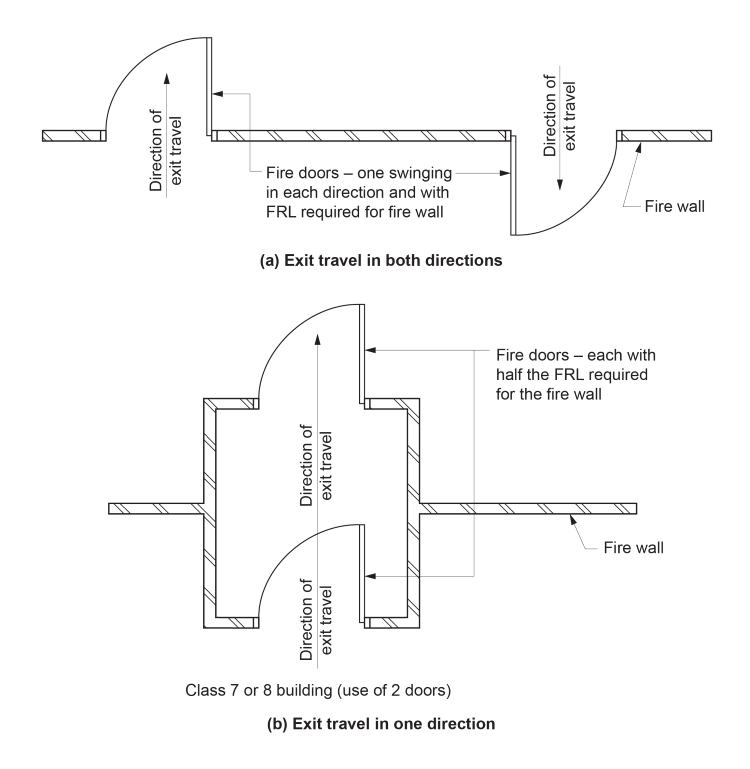
To maintain the integrity of a fire-isolated exit and to protect people using fire-isolated exits by providing adequately protected door and window openings.
Doorways
Any doorway leading into a fire-isolated exit is a possible source of fire and/or smoke spreading into that exit. The spread of fire or smoke into a fire-isolated exit is dangerous.
It is therefore important that such doorways are protected by fire doors. These fire doors must be self-closing (see C4D9(1)) or automatic-closing initiated by smoke detectors or (in specified circumstances) heat detectors (see C4D9(2)).
C4D9 has the same requirements for fire doors or shutters as C4D6 Refer to the comments made in C4D6 for application here.
C4D9 does not apply to a doorway leading from a fire-isolated exit to a road or open space, because failure of such a doorway is not affected by a fire in the building. However, note that such a doorway may require protection to comply with C4D3.
Windows
C4D9(4) only applies to a window which could expose an evacuating person or fire fighter to radiant heat from a fire in the building. Therefore, C4D9(4) does not apply to a window exposed to another window within the same fire-isolated exit.
If a sprinkler system is chosen as the means of protection in accordance with C4D5, the sprinkler heads must be located on the side of the window outside the exit.
A window subject to the requirements of C4D9(4) may also require protection from an external fire to comply with C4D3.
Fire-isolated exits must not be penetrated by any services other than—
To maintain the integrity of a fire-isolated exit and to protect the people using them by providing protection to service penetrations.
C4D10 minimises the number of service penetrations into a fire-isolated exit by only allowing the services specified. Each of the services listed in C4D10(a) and (b) is essential to maintain a safe environment within the fire-isolated enclosure.
Under C4D10(c), the water supply for fire-fighting may be located within a fire-isolated exit. Hydrants located within a fire- isolated enclosure allow the fire brigade to set up their hoses and other equipment in a protected area before attacking the fire.
The location of any service penetrations into the fire-isolated exit permitted by C4D10 must not reduce the exit width required by D2D8.
C4D10 should be read in conjunction with D3D8, which deals more generally with installations in exits and paths of travel.
To maintain the integrity of a fire-isolated lift shaft and to limit the spread of fire from one floor of a building to another floor by way of a lift shaft.
Any doorway leading into a fire-isolated lift shaft could assist the spread of fire. Any spread of fire into the shaft could endanger the lives and safety of the people using the lift, and lead to the spread of fire to another part of the building.
Therefore, it is important that such doorways be protected by fire doors.
AS 1530.4 (the Australian Standard for the Standard Fire Test) requires lift landing doors to be tested for integrity. Such doors are usually of metal construction, and are not required to satisfy any insulation criteria.
Lift indicator panels in excess of 35 000 mm2 are considered to represent a sufficient risk of spreading fire into a lift shaft. Indicator panels exceeding this size require backing by material having a fire-resistance level (FRL) of –/60/60.
Small panels of 35 000 mm2 or less are unlikely to lead to the spread of fire into the shaft. This exemption is similar in principle to those allowedby C4D2 for minor openings such as control joints, weep holes, subfloor ventilators and the like.
To maintain the performance of a wall bounding any sole-occupancy unit or public corridor in Class 2 or Class 3 buildings; and any sole-occupancy unit in a Class 4 part.
Protection of doorways
To maintain the fire performance of walls surrounding a sole-occupancy unit and corridors used as egress routes in Class 2 and Class 3 buildings, C4D12(1) and (2) requires the following doorways to be protected:
To maintain the fire performance of walls surrounding a sole-occupancy unit in a Class 4 part of a building, C4D12(3) requires the doorways to the unit to be protected.
Fire protection required for doorways
The degree of fire protection requiredby C4D12(4) for doorways to sole-occupancy units in Class 2 and Class3 buildings and Class 4 parts is dependant upon the types of construction.
C4D12(4)(a) applies to all Class 2 and Class 3 buildings and Class 4 parts in buildings of Type A construction, except those Class 3 buildings specified in C4D12(5).
C4D12(4)(b) applies to all Class 2 and Class 3 buildings and Class 4 parts in buildings of Type B or Type C construction, except those Class 3 buildings specified in C5D12(5).
C4D12(5)(a) or (b) only applies to Class 3 residential care buildings fitted with a sprinkler system complying with Specification 17. A Class 3 residential aged care building that does not meet these requirements, must comply with C4D12(4)(a) or (b) as applicable.
C4D12(4)(b) requires that the door be self-closing to make sure that the door is closed during a fire. The requirement for such doors to be self-closing does not apply to a Class 3 residential aged care building which meets the requirements of C4D12(5)(a).
Openings other than doorways
Under C4D12(6), openings other than doorways in internal walls which are required to have a fire-resistance level (FRL) for integrity and insulation are permitted only if they do not lower the wall’s fire-resisting performance.
Automatically closingdoors
Doors required by C4D12(4) and (5) may be automatic-closing, initiated by smoke detectors or (in specified circumstances) any other detector deemed suitable in accordance with AS 1670.1 (see C4D12(7)(a)). The suitability of detectors can be determined by reference to AS 1670.1. Refer to C4D6 for door operation requirements as they apply to doors under C4D12.
Path of travel to an exit
C4D12(8) and (9) applies in a Class 2 or Class 3 building only, where a path of travelis along an open balcony, landing or the like and it does not provide a person evacuating with a choice of travel in different directions to alternative exits. If this path of travel passes an external wall of another sole-occupancy unit (see C4D12(8)(c)(i)) or a room which is not within a sole-occupancy unit (see C4D12(8)(c)(ii)), the external wall must be constructed in accordance with C4D12(9)(a), have any doorways protected in accordance with C4D12(9)(b), and any window or other openings protected in accordance with C4D12(9)(c)(i) or (ii).
The reason for the above construction is to provide building occupants trying to evacuate with protection from radiant heat and flames whilst passing the unit that is on fire.
the service must be installed in accordance with (2).
To limit the spread of fire through service openings in floors and ceilings required to resist the spread of fire.
C4D13 applies to floors and ceilings in buildings of Type A, B and C construction.
The performance of a fire resisting element may be compromised if service penetrations are not adequately protected. The method of protection should ensure the fire resisting capabilities of the element being penetrated is maintained. In buildings of Type A construction, the service may be within a fire resisting shaft or protected in accordance with C4D15. In buildings of Type B and C construction the service may be within a shaft that does not reduce the fire resistance of the element it penetrates or it must be protected in accordance with C4D15.
In a building of Type A construction, an opening in a wall providing access to a ventilating, pipe, garbage or other service shaft must be protected by—
To maintain the fire performance of the floor by limiting the spread of fire through openings in shafts.
C4D14 only applies to buildings of Type A construction, because the other types of construction do not require service shaft walls to have a fire-resistance level (FRL).
C4D14 sets out the detail of the protection required in different circumstances to prevent the spread of fire from one floor to another floor by way of a shaft.
To maintain the fire performance of building elements by limiting fire spread by way of service penetrations.
C4D15 sets out a number of requirements for protection of service openings. These include:
C4D15 considers the protection of openings in elements that are providing a barrier to the spread of fire and are thus required to have an FRL. The elements of an FRL that providethe barrier to spread of fire are insulation and integrity and that protecting an opening in an element an FRL for structural adequacy is unnecessary. For this reason, C4D15 only applies to an element required to have an FRL with respect to integrity or insulation.
In addition to complying with C4D15(2), the construction of any fire rated shaft may also need to comply with other Deemed-to-Satisfy provisions, such as S5C8. In some instances, AS 1668.1 may provide a concession for the construction of a shaft or protection of some penetrations in that shaft’s construction. However, the construction of the shaft itself and protection of service penetrations need to be considered together.
Tested systems permitted
C4D15(2)(a)(i) quite clearly permits the use of tested systems. To comply with this Deemed-to-Satisfy Provision it is necessary for the appropriate authority to be satisfied that the proposal is identical to a tested prototype, or varies in accordance with Section 4 of AS 4072.1. AS 1530.4 includes a number of methods of reporting the test results. These include—
Only the test report and regulatory information report contain sufficient information to allow the appropriate authority to be satisfied that the proposal is identical with the tested prototype or differs from the prototype in accordance with AS 4072.1.
It should be noted that the provision only applies to the service where it penetrates the building element. Although AS 4072.1 and AS 1530.4 requires a tested penetration to extend a specified distance beyond the penetration opening for the purpose of carrying out the test, the NCC only requires the building element and the part of the service penetrating that element to be identical with the tested prototype or different from the prototype in accordance with AS 4072.1.
Examples
Consider a service penetration consisting of a plastic pipe passing througha concrete floor to a hand basin. AS 1530.4 requires the tested prototype service pipe to extend 2 m above the floor. However, due to the height of the hand basin above the floor, the pipe is unlikely to extend more than say 800 mm. C4D15(2)(a)(i) allows this configuration provided it is identical to the tested prototype where the service pipe passes through the floor or differs from the prototype in accordance with AS 4072.1.
Variation from tested systemsfor metal piping systems
C4D15(2)(a)(ii) allows a concession from the insulation criteria of a tested prototype specified in C4D15(2)(a)(i). The concession only applies for penetrations by metal piping systems where the service pipe is not located within an exit (see C4D15(2)(a)(ii)(D)) and is at least 100 mm from any combustible building element for a distance of 2 m from the penetration of the building element (see C4D15(2)(a)(ii)(B)). To ensure that fire is not spread via the conduction of heat from the metal pipe, it is important that the service pipe be located so that combustible material cannot be located within 100 mm of the pipe for a distance of 2 m from the penetration (see C4D15(2)(a)(ii)(C)). One method of achieving this would be to place a guard around the pipe.
In the case of a floor waste, it would not be possible to ensure that no combustible material is located within 100 mm of it. Therefore, C4D15(2)(a)(ii) is unlikely to apply to floor wastes.
Approval of other types of penetrations
Specification 13 does not apply to larger diameter electrical cables (i.e. where the opening is larger than those specified in Clause S13C5(b) of 2 000 mm2 or 500 mm2). This does not mean that larger diameter electrical cables cannot be approved under C4D15. Larger diameter electrical cables can be approved under C4D15(2)(a)(i)(A) (i.e. a tested system), C4D15(2)(a)(i)(B) where in accordance with AS 4072.1, or if necessary, as a Performance Solution.
Gas pipes can be approved under C4D15(2)(a)or, if necessary, as a Performance Solution.
To limit the spread of fire between building elements required to be fire-resisting.
To avoid the spread of fire between fire compartments or to another building, construction joints between building elements are normally packed with fire retardant material.
A number of proprietary products are suitable for this purpose, having previously been tested in accordance with AS 1530.4 to demonstrate they have achieved the required fire-resistance level (FRL). The test only needs to record the failure criteria of integrity and insulation. C4D16 does not require structural adequacy criteria to be achieved, as it is not part of the AS 1530.4 test for these types of materials.
A column protected by lightweight construction to achieve an FRL which passes through a building element that is required to have an FRL or a resistance to the incipient spread of fire, must be installed using a method and materials identical with a prototype assembly of the construction which has achieved the required FRL or resistance to the incipient spread of fire.
To prohibit columns with lightweight fire protection from lowering the fire-resistance levels (FRLs) of other building elements.
If lightweight fire protection has been inadequately applied to a column, there is an increased risk that the column will transmit heat to another building element (such as a floor or ceiling) through which it passes. The effect is that the column can cause a reduction in the fire-resistance level (FRL) or resistance to the incipient spread of fire of the elements through which it passes. This can result in the spread of fire. To eliminate this potential problem, it is necessary to use a system tested in accordance with AS 1530.4.
Where external stairs, ramps or ladders are used as an exit in a bulk grain storage facility, any window or door opening within 6 m of the stairway or ladder—